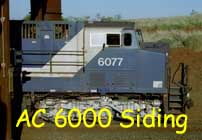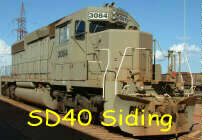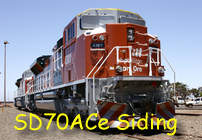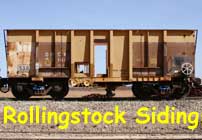The BHP mainline at 426 km long runs from Nelson Point and Finucane Island (Port Hedland) to Newman (or the Mt Whaleback Mine) with a junction at Yandi Junction [281 km], where the mainline continues on towards the MAC™, or Mining Area C mine which was originally a Goldsworthy Mining Limited lease known as Mining Area C, past the spur lines to both Yandi One [closed] and Yandi Two mines. And the other junction is at Jimblebar Junction (401 km) which includes a marshalling yard, with one line south running for 17 km where the branch for Orebody 18 leaves the line to the Jimblebar Hub and siding to Wheelarra Hill. The area was formerly McCamey's Monster, later renamed by BHP to Jimblebar. With the other line from Jimblebar Junction runs out to the south west to Mt Whaleback (415.9 km) past Ore Body 25 line at the 406 km [closed] and the Ore Body 24 spur (416.8 km) to finish up at the loadouts and car dumper at Whaleback.
BHP are currently running 22 to 24 departures a day to the mines on the Newman / Yandi and MAC lines. The MAC loadout balloon is duplicated with dual loadout circuits for the South Flank ore which arrives via an overland conveyor.
Train lengths are based on two 135 car rakes for up to 270 waggons, with the mid-train units controlled via radio link from the lead unit in a system known as 'Locotrol' or 'Distributed Power'.
The Golynx bottom discharge cars (8400 series) that were used on the Goldsworthy system between Finucane Island and Yarrie/Nimingarra have been converted to rotary dump cars and now see service system wide, including 8400, which still carries the stencils 'GML ONLY'.
Expansion of the operation now sees BHP producing close to 250 million tonnes per annum (2020 run rate) with the railway duplicated from Nelson Point and Finucane Island all the way to the M306 km on MAC line at the Yandi mine junction.
The duplication also includes a 34 km long 'Chichester Deviation' with one passing siding Chichester at the C235 to C239 km, this section eases the grades that loaded trains face to ~0.33 percent for 26 km. The mainline through Hesta sees loaded trains having to tackle grades above 0.41 and long drags of 0.55 percent.
With the addition of an additional rotary car dumper (CD5) at Finucane Island this has allowed increased tonnages to the Western and Eastern Yards of Yandi and MAC™ DSO or Direct Shipped Ore with the continued use of the under harbour tunnel for ore transfer from Nelson Point to Finucane Island.
The duplication works around the Hedland area has seen the old road to Finucane which ran right beside the railway moved east onto the Pilbara Port Authority access road with the former becoming the east main to Finucane Island. The south leg of the Goldsworthy Triangle, also duplicated, is called the 'avoidance road' which duplicates the original GML leg of the triangle with the junction now a double track junction with dual tracks to both FI and NP. A far cry from the once former diamond.
Trains are now regularly made and broken up at a new staging complex at the Mooka Staging Facility [MSF], located west of the original Mooka Siding. Mooka yard consists of five roads on the west side of the line and is spread over almost ten kilometres in length. On the east side of the line is the new Mooka OCRS or Ore Car Repair Shop, a state of the art automated ore car repair facility. The original OCRS located within Nelson Point is still in use for the long term and major structural repairs to the waggons. Trains are still marshalled at Bing but to a lesser degree. With the Main Roads Wedgefield bypass including a bridge over the GML line at Boodarie, this area can now also receive full size two rake trains (270 waggons) which allows trains to be broken in two at Boodarie.
Normal operation sees empty single rakes leave Boodarie yards and be marshalled into a single train at Mooka or Bing, with single rake and full size 2 rake trains originating from Nelson Point to run to the mines or to Bing / Mooka as required for staging.
Full size trains (up to 270 waggons) are regularly sent into Nelson Point as they have the yard arrangement to handle them.
Area flood lighting allows for round the clock operation at Bing and Mooka.
Train movements are controlled from the Train Control centre located in Perth at the Integrated Remote Operations Centre with five control desks, being:
'Hedland Control' looking after the Newman mainline from the 67km (located south of Walla) to the 260km on Ch 1.
'Newman Control' looking after the Newman mainline from the 260km to 384km and the MAC™ and Yandi lines on Ch 2.
'6PG' or Goldsworthy looking after the Yarrie line and the Hedland area from Finucane Island to the 67km, inc. Goldsworthy Junction and Boodarie and Bing yards on Ch 6.
'Hub Control' looking after the 384km to Newman and Jimblebar and all movements south around the Jimblebar, Orebody 18 and Orebody 24 mines on Ch 4.
And 'Yard Control' which controls the Hedland (Nelson Point) Yard on Ch 3.
Communications and all track devices are controlled across an extensive VHF radio system with solar powered microwave linked repeaters. All track side infrastructure as in signals, switch motors and monitoring devices are solar powered and are monitored and controlled out of Nelson Point via a computer controlled Siemens' Vicos Train Control System.
A trunking style scanner is required for the BHP system as they use a P25 based unencyted system.
A printable PDF covering BHP's P25 system and Rio's conventional UHF network can be downloaded here.





FXH70C Battery Electrics









Pilbara Power Parade



ALCo Images



